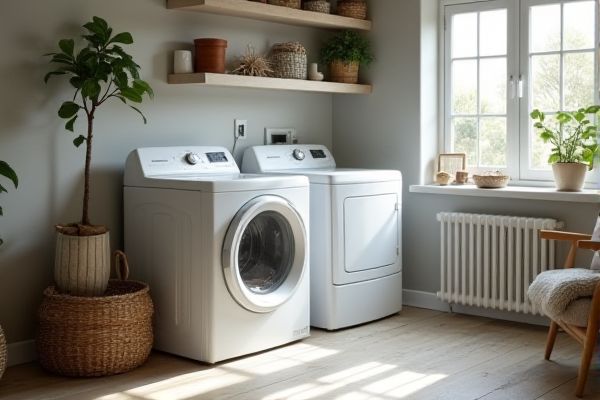
Heat pump dryers use advanced technology to recycle air and operate more energy-efficiently than vented dryers, which expel hot, moist air outside, potentially increasing energy costs. Explore the detailed comparison in this article to determine which dryer best suits your laundry needs and energy goals.
Table of Comparison
| Feature | Heat Pump Dryer | Vented Dryer |
|---|---|---|
| Energy Efficiency | High efficiency, uses less electricity (A++ rating) | Lower efficiency, higher energy consumption |
| Installation | Requires no external vent, flexible placement | Needs external venting, limited placement options |
| Drying Time | Moderate, slightly longer drying cycles | Faster drying times |
| Operating Cost | Lower long-term costs due to energy savings | Higher costs from greater energy usage |
| Lifespan | Longer lifespan with fewer components prone to wear | Average lifespan, vent can cause wear issues |
| Environmental Impact | Eco-friendly, reduces carbon footprint | Higher environmental impact due to energy use |
| Price | Higher upfront cost | Lower initial purchase price |
Introduction to Heat Pump Dryers and Vented Dryers
Heat pump dryers use advanced technology to recycle heat, making them energy-efficient and gentle on fabrics, while vented dryers expel moist air through an external vent, resulting in higher energy consumption. Heat pump dryers operate at lower temperatures, reducing the risk of damage to your clothes and prolonging their lifespan compared to vented models. Choosing a heat pump dryer can significantly lower your energy bills and environmental impact without compromising drying performance.
How Heat Pump Dryers Work
Heat pump dryers operate by recycling air through a heat exchange system that extracts moisture from clothes while using less energy than vented dryers. Your laundry benefits from a closed-loop process where warm air absorbs moisture from the fabric, then passes through a condenser to remove the water before being reheated and circulated back into the drum. This energy-efficient method reduces utility costs and is gentler on fabrics compared to traditional vented dryers that expel hot, moist air outside.
How Vented Dryers Operate
Vented dryers operate by drawing in air, heating it to remove moisture from clothes, and exhausting the damp air outside through a vent. This constant airflow ensures efficient drying but requires proper ventilation installation to avoid humidity buildup indoors. Your choice between a vented dryer and a heat pump dryer depends on available space and energy efficiency preferences.
Energy Efficiency Comparison
Heat pump dryers consume up to 50% less energy compared to vented dryers by recycling heat during the drying process, making them significantly more energy-efficient. Vented dryers expel hot air and draw in new air, leading to higher electricity usage and increased operating costs. Choosing a heat pump dryer can substantially reduce Your household's energy consumption and utility bills.
Drying Performance and Speed
Heat pump dryers offer more energy-efficient drying by recycling heat, resulting in gentler drying cycles that protect delicate fabrics but typically require longer drying times compared to vented dryers. Vented dryers expel moist air directly outside, enabling faster drying performance but consuming more energy and potentially causing higher wear on clothes. Choosing between the two depends on balancing drying speed with energy efficiency and fabric care needs.
Environmental Impact and Sustainability
Heat pump dryers consume up to 50% less energy than vented dryers by recycling heat, significantly reducing carbon emissions and lowering electricity bills. Vented dryers expel hot, moist air outside, resulting in higher energy usage and contributing to greater environmental degradation. Choosing a heat pump dryer supports sustainability through energy efficiency and decreased greenhouse gas emissions.
Installation and Maintenance Requirements
Heat pump dryers require a more complex installation as they do not need external venting, making them ideal for apartments or spaces without easy access to an exterior wall. Maintenance for heat pump dryers involves regular cleaning of filters and condensers to ensure efficiency and prevent overheating. Vented dryers need proper ductwork to vent hot, moist air outside and typically require less frequent filter cleaning but demand periodic inspection of vents to avoid lint buildup and potential fire hazards.
Noise Levels and User Experience
Heat pump dryers operate with significantly lower noise levels, typically around 50-60 decibels, enhancing user comfort in residential settings compared to vented dryers that often exceed 70 decibels. The quieter operation of heat pump dryers results from their closed-loop system and lower drying temperatures, minimizing disruptive sounds during cycles. Users benefit from a more peaceful laundry environment with heat pump models, making them ideal for open-plan homes or apartments where noise reduction is a priority.
Cost Analysis: Purchase and Running Costs
Heat pump dryers have a higher upfront cost compared to vented dryers but offer significant savings in running costs due to their energy-efficient technology, consuming up to 50% less electricity. Vented dryers are cheaper to buy but tend to have higher operational expenses because they use more power and may increase your electricity bill over time. Considering long-term energy savings, a heat pump dryer can be a more cost-effective investment for Your household despite the initial price difference.
Which Dryer Is Right for You?
Choosing between a heat pump dryer and a vented dryer depends on your energy efficiency goals and space availability. Heat pump dryers use advanced technology to recycle hot air, significantly reducing energy consumption and operating costs, making them ideal for eco-conscious users. If you have limited ventilation options or want to minimize energy bills, your best option is a heat pump dryer, while vented dryers work well in well-ventilated spaces and typically offer faster drying times at a lower upfront cost.
 homyna.com
homyna.com